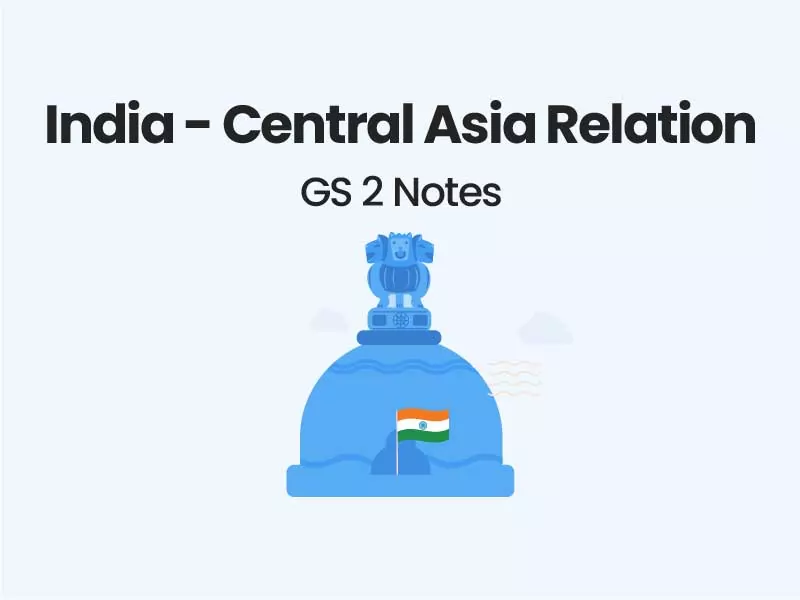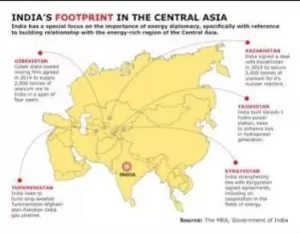Companion@360 → 7 Month programme to sharpen your writing skills → REGISTER NOW

India – Central Asia Relation
India and the region of Central Asia have very long historical, cultural, and economic connections. The famous Silk Route not only connected the people and businesses, but also let the thoughts, culture and beliefs flow freely from one region to the other.
Background
The five Central Asian Republics (CARS) viz Kazakhstan, Kyrgyzstan, Tajikistan, Turkmenistan, and Uzbekistan attained independence on the disintegration of the Soviet Union in 1991.
India was among the first countries to recognize the five Central Asian states and established diplomatic relations with them.
India now considers the Central Asian countries as part of its “extended and strategic neighbourhood”.
In 2012, India announced the ‘Connect Central Asia’ policy, and also announced to hold an India-Central Asia Dialogue at Track II annually in one of the Republics.
Significance of Central Asia to India
Energy Security – The countries of Central Asia are endowed with significant hydrocarbon and mineral resources and are close to India geographically
- Kazakhstan is the largest producer of uranium and has huge gas and oil reserves as well
- Uzbekistan is also rich in gas and is an important regional producer of gold along with Kyrgyzstan.
- Tajikistan has vast hydropower potential besides oil deposits.
- Turkmenistan has the fourth largest gas reserves of the world.
Strategic Location – Central Asia serves as a land bridge between Asia and Europe, making it geopolitically axial for India.
- India’s only foreign military airbase is in Farkhor (Tajikistan), which is operated by IAF and Tajik Air Force.
Trade and Investment potential – The economic development activities in the region has led to a construction boom and development of sectors like IT, pharmaceuticals, and tourism.
- India has expertise in these sectors and deeper cooperation will give a fresh impetus to trade relations with these countries.
- There is a great demand for Indian pharmaceutical products in the region.
Security – being located close to the ‘Golden Crescent of opium production (Iran-Pak-Afghan), Central can help to tackle the challenge of narcotics trafficking and arms smuggling.
Counter terrorism and radicalization – keeping a check on the rise of radical Islamist groups that may pose a threat to India’s security.
Stabilization of Afghanistan – Central Asian nations and India can effectively play role in bringing normalcy in Afghanistan.
India has not been able to take advantage of its civilizational and historical ties with the region as adequate attention was not accorded to the relation till recently. India’s relations with the Central Asian countries are hampered by geography, economic constraints, security concerns and red-tapism.
Challenges in Relation
Low Accessibility – India does not share physical border with any of the Central Asian states, which is a landlocked region.
The adverse geographic terrain and the thorny India-Pakistan border dynamics, greatly impedes connectivity, thereby curbing greater economic cooperation between India and the region.
Below par trade – At present the five Central Asian republics account for trade of only about $2 billion with India, compared to about $50 billion with China that has made them a key to its Silk Road Economic Belt (SREB) initiative.
Growing influence of China in Central Asia – China’s One Belt and Road Initiative (BRI) seems to be a credible threat to India’s objective on overcoming connectivity issues with Central Asia.
Security issues – porous border and unbridled corruption along with the proximity with regions of soaring opium production (Golden Crescent and Golden Triangle) makes the region a powerhouse for drug and money trafficking.
Instability in Neighbouring regions – The unstable situation in Afghanistan and a highly problematic India-Pakistan relation have deprived India from the benefit of relations with Central Asia.
Domestic challenges – emerging from religious extremism, authoritarian regimes, terrorism, ongoing conflicts etc is in itself a challenge in furthering India’s economic interests.
Administrative laggards in the region – such as non-availability of hard currency, banking services, and prevailing corruption creating roadblocks in smooth bilateral relations.
Indian efforts to strengthen Cooperation
Connect Central Asia policy – launched in 2012 to strengthen strategic, economic, and security cooperation.
Shanghai Cooperation Organization (SCO) membership – With full membership of SCO, there will be more frequent summit level contacts between the top leaderships of India & CARs.
International North-South Transport Corridor (INSTC) – a multi-modal transport project to connect Indian Ocean and Persian Gulf to the Caspian Sea.
Chabahar Port in Iran – Once the Chabahar port is ready, along with INSTC it can become an important anchor for trade to and from Central Asia via Afghanistan.
Signing of Ashgabat Agreement – an international transport and transit corridor facilitating transportation of goods between Central Asia and the Persian Gulf.
Turkmenistan-Afghanistan-Pakistan-India (TAPI) gas pipeline – to supply natural gas from Turkmenistan to India.
Eurasian Economic Union (EEU) – India is negotiating a comprehensive economic partnership agreement with the Eurasian Economic Union, which include Belarus, Kazakhstan, Russia, Armenia, and Kyrgyzstan.
India-Central Asia Dialogue – provides a platform for strengthening cooperation between India and Central Asian countries.
India-Central Asia Business Council (ICABC) – launched in February 2020 and comprises the Federation of Indian Chambers of Commerce and Industry (FICCI) and chambers of commerce from the 5 central Asian countries.
Indian Technical and Economic Cooperation (ITEC) Program provides technical assistance and training in areas such as banking, remote sensing, and information technology etc in the premier institutions in India.
Both India and Central Asia are factors of peace, stability, growth, and development, in the region and the world. Stronger relations between them will contribute to increased security and prosperity of these countries and the world.
Read Full GS Notes
Way Forward
India should leverage its soft power and its ready acceptability in Central Asia to strengthen bilateral ties.
More energy and vigour need to be imparted to the area of commercial and economic ties.
Exploring Air Routes – While incentivising the use of Chabahar port, India must simultaneously develop the air route by promoting easy flight connectivity.
India can create an Air Corridor, like the one it has with Afghanistan
Utilizing untapped potential – Chambers of Commerce as well as official government agencies need to be more active to bridge the ‘’information deficit’’ between India and the region.
India provides an assured and competitive market to these countries for their energy, raw materials, oil and gas, uranium, minerals, hydro-electric power etc.
Private sector participation also must be encouraged through trade fairs and organizing single country trade fairs in major commercial and industrial centres of these countries.
Textile Industry – Cooperation in silk manufacturing is one of the many opportunities present in Central Asia.
High-quality cotton production from all Central Asian countries can be a boon for Indian textile industries.
It can ensure rural growth, poverty alleviation and job opportunities for both India and Central Asia.
Food Security – Central Asia has huge cultivable areas lying barren and without being put to any productive use, offering enormous opportunity for cultivation of pulses.
Indian agribusiness companies can setup commercial agro-industrial complexes in Central Asia.
India’s experience in boosting food and milk production and modernizing Agro-techniques under the green and white revolution can prove panacea for Central Asia.
Measures such as relaxing of visa regimes, establishing schools and universities; strengthening tourism; Investment in agriculture sector can significantly improve India’s position in the region.
India-Central Asia ties have the potential to raise India’s stature in the international system. India’s increased presence in the region would ensure stability, security, economic growth, and development. This, in turn, would enable India to realise its energy needs and address security concerns. Thus, giving equal importance to India’s extended neighbourhood is vital for realising its aspiration of becoming a major power.
Previous Year Questions
A number of outside powers have entrenched themselves in Central Asia, which is a zone of interest to India. Discuss the implications, in this context, of India’s joining the Ashgabat Agreement, 2018. (2018)


